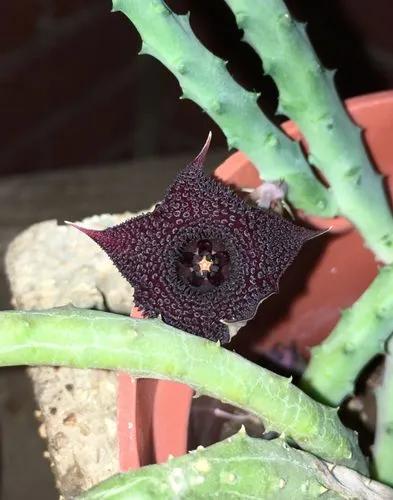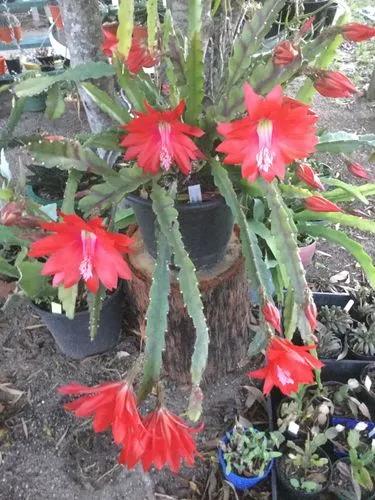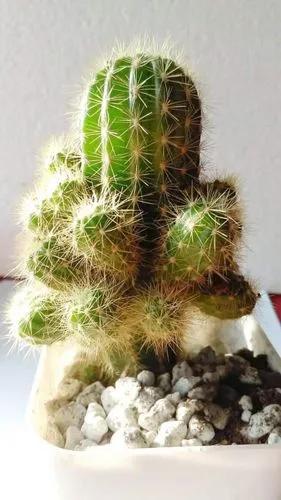Cereus are shrubby or treelike, often attaining great heights (C. hexagonus, C. lamprospermus, C. trigonodendron up to 15 m). Most stems are angled or distinctly ribbed, ribs 3–14 cm long, usually well developed and have large areoles, usually bearing spines. Cephalium is not present, Cereus mortensenii develops pseudocephalium. Flowers are large, funnelform, 9–30 cm long, usually white, sometimes pink, purple, rarely cream, yellow, greenish, and open at night. Fruits are globose to ovoid to oblong, 3–13 cm long, fleshy, naked, usually red but sometimes yellow, pulp white, pink or red. Seeds large, curved ovoid, glossy black.
Cereus Cacti Care
Cereus



How to Care for the Plant

Water

Weekly watering should be sufficient for the water needs of this cacti family. They need a solid supply of water during the summer, but make sure not to overwater them, which can cause rot. A good test is to stick your finger into the soil about a few inches down. If the soil is dry there, it's likely time to water.

Pruning

Occasionally

Fertilizer

This cactus family is already known to grow quickly, but a bit of added fertilizer can't hurt—in fact, it may help them grow even faster. Complementing their watering with a diluted liquid fertilizer once every few weeks during the growing season for best results. Be sure to use a balanced fertilizer like a 20-20-20 that's been diluted so it doesn't burn your cactus.

Sunlight

I will be happy indoors where I can get bright, indirect light. However, I am very strong and resilient so I could tolerate medium light or even full sun outdoors.

Soil

You can use a standard cactus potting soil or create a mixture of coarse sand and peat for propagating cereus cactus. Choose a container that drains well, such as a terra cotta pot, and one that is just a couple of inches bigger than the diameter of the leaf.

Temperature

Temperature. From spring to fall, Cereus cacti like hot temperatures between 70 and 95 ºF (21 and 35 ºC). In winter, cold to 50 ºF (10 ºC). Most species are grown outdoors in USDA hardiness zones 9a to 10b, 20 to 40 °F (-6.7 to 4.4 °C).

Container

The self-watering containers require a deep and thorough watering of the topsoil after they are first placed. This is important because the roots of the plants first need to grow into the reservoir in order to drink from it. Follow the standard planter instructions for at least four weeks, before testing the reservoir. During the dormant seasons, or for plants that have slower growing habits, consider top watering for up to ten weeks.
TEST: After the initial top water period, fill the water reservoir until the red indicator reaches half way between the MAX and MIN line. If the indicator goes down over the first few days, it means the plant is ready for regular reservoir servicing. If not, be sure to continue top watering for a few more weeks, until the red indicator goes down, meaning the plant has started drinking from the reservoir.
RESERVOIR SERVICING: Once the indicator goes down, do not refill the reservoir right away. Similar to how humans need a breath of air between gulps of water, almost all plants require a drying out period. Always allow for the reservoir to empty all the way, and after a drying out period of a few days, be sure to refill it until the indicator reaches the MAX line.

Additional

Night-blooming cereus is listed by the ASPCA as non-toxic to cats, but because plants aren't part of a cat's normal diet, ingestion can lead to side effects, which include gastrointestinal irritation, skin irritation, vomiting, and blistering or irritation of the gums and mouth. Members of the genus Cereus are generally shrub- or treelike cacti with 4–10 ribs on each stem. The ribs are lined with rows of large areoles, each of which is armed with several stout spines. The spherical or oblong fruits are fleshy and usually devoid of spines; the fruits of some species are edible.

Popularity

91 people already have this plant 21 people have added this plant to their wishlists
Discover more plants with the list below
Popular articles






